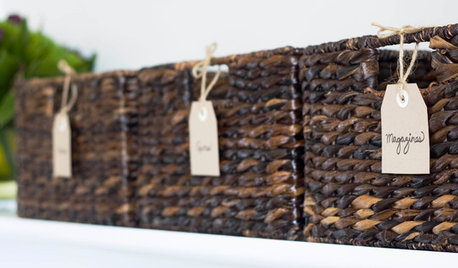getting rid of cut worms organically
desertmarcy
18 years ago
Related Stories

MOST POPULARHow to Get Rid of Those Pesky Summer Fruit Flies
Learn what fruit flies are, how to prevent them and how to get rid of them in your home
Full Story
EDIBLE GARDENSNatural Ways to Get Rid of Weeds in Your Garden
Use these techniques to help prevent the spread of weeds and to learn about your soil
Full Story
DECLUTTERINGDownsizing Help: How to Get Rid of Your Extra Stuff
Sell, consign, donate? We walk you through the options so you can sail through scaling down
Full Story
DECORATING GUIDESLose It: How to Get Rid of a Mattress
Updating your bedroom? Here's how to donate, reuse or recycle that mattress — and keep it out of the landfill
Full Story
DECORATING GUIDESLose It: 4 Ways to Get Rid of Your Old Carpet
Try one of these earth-friendly tips before stuffing your dingy carpet or rug in the trash
Full Story
ORGANIZINGWant to Streamline Your Life? Get a System
Reduce stress and free up more time for the things that really matter by establishing specific procedures for everyday tasks
Full Story
ORGANIZINGHouzz Call: Show Us How You're Getting Organized
If you’ve found successful ways to declutter and create order at home, we want to hear about it. Share your ideas and photos!
Full Story
ORGANIZINGGet Organized: Are You a Piler or a Filer?
Tote out the bins and baskets and learn how to be an organized piler if file cabinets leave you cringing
Full Story
HOUSEKEEPING7-Day Plan: Get a Spotless, Beautifully Organized Garage
Stop fearing that dirty dumping ground and start using it as the streamlined garage you’ve been wanting
Full Story
LIFE10 Best Ways to Get Organized for a Big Move
Make your next move smooth, short and sweet with these tips for preparing, organizing and packing
Full StorySponsored
Leading Interior Designers in Columbus, Ohio & Ponte Vedra, Florida
More Discussions




jean001
Kimmsr
Related Professionals
Port Royal Landscape Architects & Landscape Designers · Buford Landscape Contractors · Salem Landscape Contractors · Stamford Landscape Contractors · Addison Landscape Contractors · Deerfield Landscape Contractors · North Richland Hills Landscape Contractors · Round Lake Landscape Contractors · San Carlos Park Landscape Contractors · West Orange Landscape Contractors · Merrifield Landscape Contractors · Shafter Landscape Contractors · Grand Rapids Decks, Patios & Outdoor Enclosures · Miami Decks, Patios & Outdoor Enclosures · St John's Kirk Decks, Patios & Outdoor Enclosurespaulns
davidbooth65
tiffy_z5_6_can
pablo_nh
rhizo_1 (North AL) zone 7
nandina
Kimmsr
paulns
dchall_san_antonio
endmaine_yahoo_com
strom
csansig